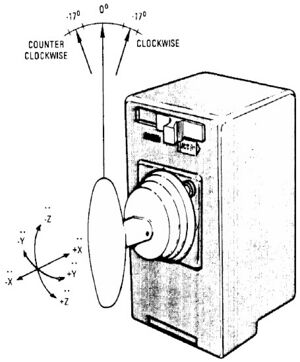Translation Hand Controller: Difference between revisions
imported>Tschachim m (print layout) |
imported>Tschachim (Link added) |
||
| Line 63: | Line 63: | ||
#[[References]] | #[[References]] | ||
</biblio> | </biblio> | ||
==External Links== | |||
* [http://ntrs.nasa.gov/archive/nasa/casi.ntrs.nasa.gov/19750010202_1975010202.pdf Apollo experience report: Crew Station Integration. Volume 3: Spacecraft Hand Controller Development] | |||
[[Category:Stabilization and Control System]] | [[Category:Stabilization and Control System]] | ||
Revision as of 11:57, 27 April 2007
The Translation Hand Controller (THC) provides the capability of manual commanding simultaneous accelerations along the spacecraft axes, that means translational manoevers. It is also used to initiate several transfer commands, to transfer the spacecraft control from CMC to SCS control for example. The real THC is basically a kind of joystick, but with some significant differences. The main functions are simulated by configuring an external joystick with the Project Apollo Launchpad Configurator, for some functions the panel is used.
Panel switches

In order to use the THC it need to be powered, which is done by switching the TRANS CONTR PWR switch A to the upper positionI.
Additionally to the translational movements the real THC may be rotated clockwise or counterclockwise. This isn't done with an external joystick, but with a small "bitmap THC" B in the lower left corner of the main panel.
- The clockwise switch (CW) will transfer spacecraft control from CMC to SCS. It may also transfer control between certain submodes within the SCS, see the Service Propulsion System for example.
- The redundant counterclockwise switches (CCW) provides for a manual abort initiation during the launch phase. A signal is fed to the master sequence controller, a SECS component, which initiates other about functions.
Joystick support

Translational control is provided by a joystick, the Launchpad Configurator allows the use of one or two joystick. If only one joystick is configured, it acts as RHC or THC depending on Orbiter's attitude control mode.
Unlike the RHC the axes of the real THC are different to the axes of a joystick. The following table shows how the joystick axes are related to the translational movements with respect to the astronaut in the spacecraft:
| Joystick | Spacecraft |
|---|---|
| Push foreward ("pitch down") | Move Down |
| Pull backward ("pitch up") | Move up |
| Push left ("roll left") | Move left |
| Push right ("roll right") | Move right |
| Turn left ("yaw left") | Move backward |
| Turn right ("yaw right") | Move foreward |
The last two axes assignments (foreward/backward) are not intuitive and different to the real THC, also not all joysticks have a yaw axis. Because of this additionally the POV "Hat" Switch can be used:
| Joystick | Spacecraft |
|---|---|
| POV foreward ("0°") | Move foreward |
| POV backward ("180°") | Move backward |
While in Orbiter's linear attitude mode, translational thruster firing with the numeric keypad is possible but unrealistic. Orbiter controls the thrusters directly without using the auto or direct thruster control coils, so this is still working without electrical power, disabled coils etc. The RCS thrusters still need proper fuel supply though.
<biblio force=false>
#I The TRANS CONTR PWR switch receives power from the SCS CONTR/AUTO MNA/B circuit breakers on panel 8 #References
</biblio>